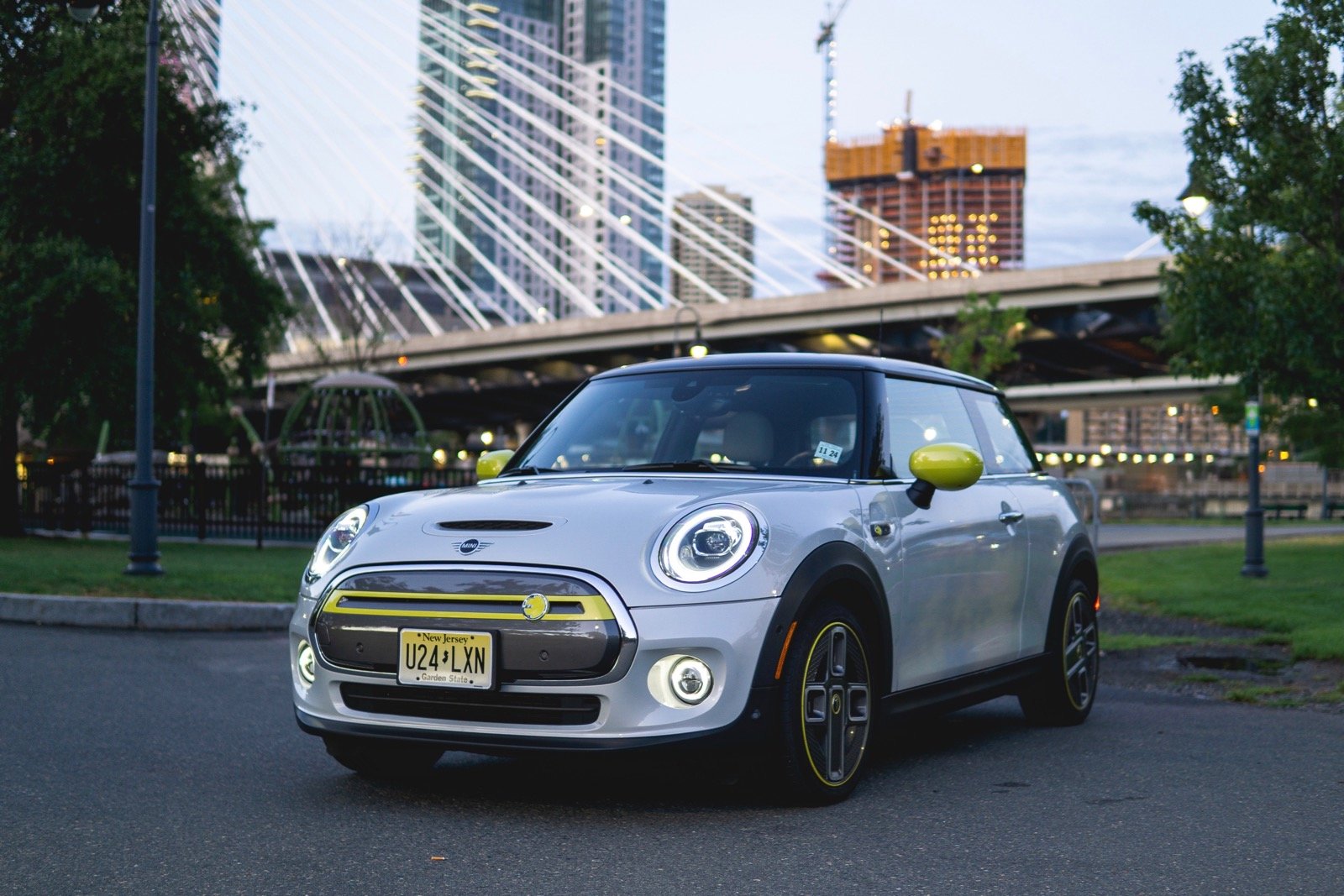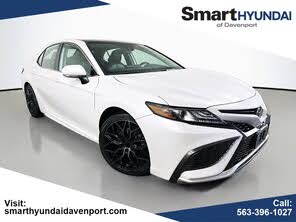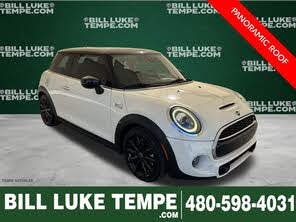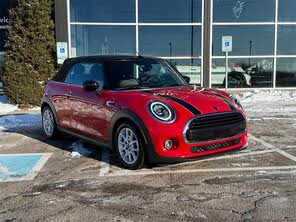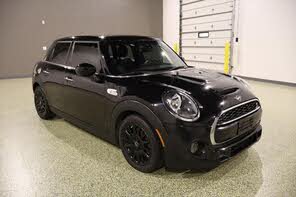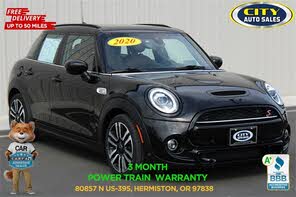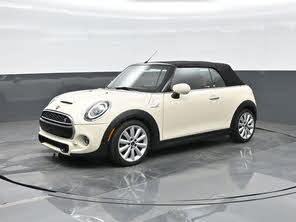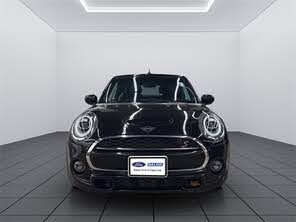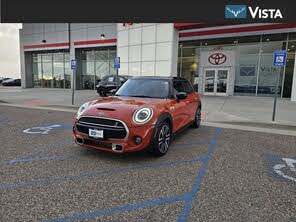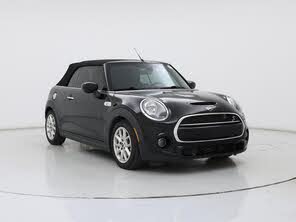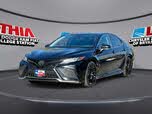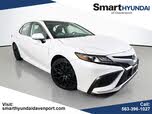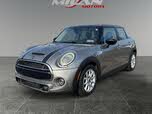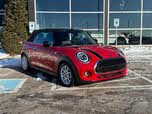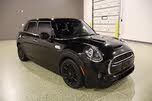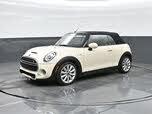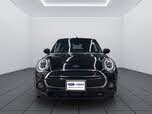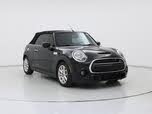2021 Toyota Camry vs 2020 MINI Cooper
Overview | |
MSRP$23,400 | MSRP$25,045 |
Listings158 | Listings1419 |
Ratings & Reviews | |
User Reviews | User Reviews |
Expert reviews7.3 out of 10 | Expert reviews7.8 out of 10 |
Pros
Cons
| Pros
Cons
|
2020 MINI Cooper Reviews SummaryThe MINI Cooper showcases timeless design and encourages even the timidest driver to live out their inner Mario Kart fantasies. With a short wheelbase, low curb weight, and torquey engines, the MINI Cooper delivers more smiles per square foot than most competitors. And with a new electric powertrain option, it can do so with a green footprint, too. | |
2021 Toyota Camry Reviews SummaryThe Toyota Camry has long been many new-car buyers’ default choice—but not because it’s interesting. Reliability and practicality have traditionally been the Camry’s strengths, not sportiness or style. Toyota tried to change that for the 2018 model year, when the Camry was last redesigned. The current-generation Camry adopted more extroverted styling, and engineers tried to make the driving experience more exciting, too. While Toyota’s approach has changed, the Camry still competes against the same array of midsize sedans, including the Honda Accord, Hyundai Sonata, Mazda 6, Nissan Altima, Subaru Legacy, and Volkswagen Passat. Changes for the 2021 model year include subtle styling tweaks, new infotainment displays, an upgrade to the Toyota Safety Sense 2.5+ (TSS 2.5+) package of driver aids, some changes to the dashboard trim, and the discontinuation of the Camry L trim level. That leaves the Camry LE as the new base trim level. The Camry offers buyers more choices than many rivals, encompassing three powertrains (inline-four, V6, and hybrid), six trim levels (LE, XLE, SE, SE Nightshade Edition, XSE, and TRD), and the choice of front-wheel drive (FWD) or all-wheel drive (AWD). Our test car was an AWD SE Nightshade Edition, positioned close to the middle of the lineup. | |
No video found | No video found |
Popular Features & Specs | |
Engine1.5L 134 hp I3 | Engine2.5L 203 hp I4 |
Drive TrainFWD | Drive TrainFWD |
Seating Capacity4 | Seating Capacity5 |
Horsepower134 hp @ 4400 rpm | Horsepower |
MPG City28 | MPG City28 |
MPG Highway36 | MPG Highway39 |
Engine | |
Engine Name1.5L 134 hp I3 | Engine Name2.5L 203 hp I4 |
Torque162 lb-ft @ 1250 rpm | Torque |
Horsepower134 hp @ 4400 rpm | Horsepower |
DrivetrainFWD | DrivetrainFWD |
Fuel Economy | |
MPG City28 | MPG City28 |
MPG Highway36 | MPG Highway39 |
Interior | |
Seating Capacity4 | Seating Capacity5 |
Safety | |
Front Crash Overall4 | Front Crash Overall5 |
Side Crash Overall4 | Side Crash Overall5 |
Dimensions & Capacity | |
Cargo Space8.7 cu ft | Cargo Space15.1 cu ft |
Curb Weight2625 lbs | Curb Weight3310 lbs |
Height55.7 in | Height56.9 in |
Length151.1 in | Length192.1 in |
Width76.1 in | Width72.4 in |
Wheelbase98.2 in | Wheelbase111.2 in |
Maximum Payload680 lbs | Maximum Payload925 lbs |
Number of doors2 | Number of doors4 |
Overview | ||
MSRP | $23,400 | $25,045 |
Listings | ||
Ratings & Reviews | ||
User reviews | ||
Expert reviews | 7.3 out of 10Read full review | 7.8 out of 10Read full review |
Pros & cons | Pros
Cons
| Pros
Cons
|
Summary | The MINI Cooper showcases timeless design and encourages even the timidest driver to live out their inner Mario Kart fantasies. With a short wheelbase, low curb weight, and torquey engines, the MINI Cooper delivers more smiles per square foot than most competitors. And with a new electric powertrain option, it can do so with a green footprint, too. | The Toyota Camry has long been many new-car buyers’ default choice—but not because it’s interesting. Reliability and practicality have traditionally been the Camry’s strengths, not sportiness or style. Toyota tried to change that for the 2018 model year, when the Camry was last redesigned. The current-generation Camry adopted more extroverted styling, and engineers tried to make the driving experience more exciting, too. While Toyota’s approach has changed, the Camry still competes against the same array of midsize sedans, including the Honda Accord, Hyundai Sonata, Mazda 6, Nissan Altima, Subaru Legacy, and Volkswagen Passat. Changes for the 2021 model year include subtle styling tweaks, new infotainment displays, an upgrade to the Toyota Safety Sense 2.5+ (TSS 2.5+) package of driver aids, some changes to the dashboard trim, and the discontinuation of the Camry L trim level. That leaves the Camry LE as the new base trim level. The Camry offers buyers more choices than many rivals, encompassing three powertrains (inline-four, V6, and hybrid), six trim levels (LE, XLE, SE, SE Nightshade Edition, XSE, and TRD), and the choice of front-wheel drive (FWD) or all-wheel drive (AWD). Our test car was an AWD SE Nightshade Edition, positioned close to the middle of the lineup. |
Video | No video found | No video found |
Popular Features & Specs | ||
Engine | 1.5L 134 hp I3 | 2.5L 203 hp I4 |
Drive Train | FWD | FWD |
Seating Capacity | 4 | 5 |
Horsepower | 134 hp @ 4400 rpm | |
MPG City | 28 | 28 |
MPG Highway | 36 | 39 |
Engine | ||
Engine Name | 1.5L 134 hp I3 | 2.5L 203 hp I4 |
Torque | 162 lb-ft @ 1250 rpm | |
Horsepower | 134 hp @ 4400 rpm | |
Drivetrain | FWD | FWD |
Fuel Economy | ||
MPG City | 28 | 28 |
MPG Highway | 36 | 39 |
Interior | ||
Seating Capacity | 4 | 5 |
Safety | ||
Front Crash Overall | 4 | 5 |
Side Crash Overall | 4 | 5 |
Dimensions & Capacity | ||
Cargo Space | 8.7 cu ft | 15.1 cu ft |
Curb Weight | 2625 lbs | 3310 lbs |
Height | 55.7 in | 56.9 in |
Length | 151.1 in | 192.1 in |
Width | 76.1 in | 72.4 in |
Wheelbase | 98.2 in | 111.2 in |
Maximum Payload | 680 lbs | 925 lbs |
Number of doors | 2 | 4 |
The 2020 MINI Cooper stood out on the road with its unique design, featuring wide-eyed LED-ringed headlights, a grinning front grille, and vibrant color options. The Union Jack taillights were particularly eye-catching. Despite its distinctive styling, the Cooper managed to avoid being wasteful or gaudy, exuding charm and inviting praise. Initially available only as a two-door hardtop, the MINI Cooper evolved to include a convertible variant, a four-door body style, and an all-electric SE trim. The SE trim, which we tested, maintained much of the design elements of the gas-powered Cooper S but sat slightly higher to accommodate the battery cells. Inside, the MINI Cooper's design was dominated by circles, with circular speakers, air vents, door handles, and a massive circular housing for the touchscreen infotainment system. The interior delivered a premium feel, unmatched by other cars of its size.
The 2021 Toyota Camry aimed to distance itself from its predecessors with a more exciting design, incorporating flared wheel arches and thin headlights and taillights that visually widened the car. However, the SE, XSE, and TRD trims featured fake vents that added visual clutter. The LE and XLE models had a cleaner, though still massive, grille. The 2021 model year saw minor changes to the front-fascia styling, with the TRD performance model getting unique elements like a larger rear spoiler. The Nightshade Edition, based on the SE trim, featured blacked-out exterior trim and wheels. Inside, the Camry's dashboard had a chaotic mix of trim elements, including contrast stitching, piano black plastic, and plastic trim resembling carbon fiber. The materials felt low-rent, and the overall design lacked a cohesive theme.










The 2020 MINI Cooper SE excelled in performance with its 181-horsepower electric motor and 199 pound-feet of torque, powered by a 32.6-kilowatt-hour battery pack. These figures were just below the Cooper S's 2.0-liter turbocharged inline four-cylinder engine, which generated 189 hp and 207 lb-ft. The SE felt quick off the line due to the immediacy of the electric motor's torque delivery. The SE also featured regenerative braking, which could be aggressive but helped keep the battery charged. Despite weighing roughly 300 pounds more than the Cooper S, the SE's low center of gravity, direct steering, limited body roll, and wide-open sight lines maintained the classic MINI driving experience. Gas-powered Coopers offered either a seven-speed dual-clutch automatic transmission or an eight-speed automatic in the John Cooper Works trim, while the SE used a single-speed gearbox. No manual transmission was available for 2020, but a six-speed manual was set to return in 2021.
The 2021 Toyota Camry offered a base 2.5-liter four-cylinder engine with 203 horsepower and 184 pound-feet of torque in FWD, and slightly lower figures in AWD. The XSE models had a dual-exhaust system, bumping output to 206 hp and 186 lb-ft in FWD. The Camry also offered a 3.5-liter V6 with 301 hp and 267 lb-ft of torque, and a hybrid powertrain with a total system output of 208 hp. Our SE Nightshade Edition test car had the base four-cylinder and AWD, which provided a surprisingly sporty driving experience. The Dynamic Force engine was eager to rev and had a pleasant sound. The chassis struck a good balance between handling and ride quality, making the Camry fun to drive without being too stiff. The TRD model, introduced in 2020, added performance upgrades like lowered suspension, stiffer coil springs, and bigger brakes. The AWD system, derived from the RAV4, could send up to 50% of torque to the rear wheels but reverted to FWD when extra traction wasn't needed.
The 2020 MINI Cooper hatchback was not ideal for carpooling, road trips, or home-improvement projects. Front-seat space was good, and the large windows prevented a claustrophobic feel. However, the backseat was tiny and best suited for children. The two-door Cooper offered 8.7 cubic feet of cargo space, while the four-door version provided 13.1 cubic feet. The Convertible had only 5.7 cubic feet. Dropping the rear seats in the SE trim increased cargo space to 25.8 cubic feet, still less than half of what a Volkswagen Golf offered. Despite limited space, the MINI Cooper was thoughtfully designed, with features like two-zone automatic air conditioning and ergonomic controls. The materials felt top-notch, reflecting BMW's investment in the MINI brand.
The 2021 Toyota Camry offered generous rear headroom and legroom, though front headroom and legroom were below average. The front seats were adjustable and comfortable, with excellent outward visibility. Cargo space was 15.1 cubic feet, average for a midsize sedan but less than the Honda Accord's 16.7 cubic feet. In-cabin storage was limited, with small cupholders and door bottle holders. Toyota included analog controls for important functions, improving ease of use, though some controls were a long reach from the driver's seat. Dual-zone automatic climate control was available on higher trim levels.
The 2020 MINI Cooper SE featured an "eDrive" driver-information display connected to the steering wheel, which moved with the steering-wheel adjustments. The display showed vehicle speed, time, mileage, remaining charge, and drive mode. The SE had a 6.5-inch touchscreen infotainment display with Bluetooth, navigation, and Apple CarPlay. The SE Iconic trim offered an 8.8-inch screen, a wireless charging pad, and a head-up display.
The 2021 Toyota Camry's standard infotainment system included a 7-inch touchscreen, Apple CarPlay and Android Auto, Amazon Alexa compatibility, Bluetooth, Siri Eyes Free, and SiriusXM satellite radio. Higher trims had a 9-inch touchscreen, WiFi, navigation, and a nine-speaker JBL audio system. A 10-inch head-up display was available on the XSE and XLE trims. The system was functional but lacked standout graphics.
The 2020 MINI Cooper SE lacked advanced safety features, with only front and rear parking sensors and a rear-view camera included in the Iconic package. Forward-collision warning was standard, but automatic emergency braking was unavailable. The IIHS gave the 2020 MINI Cooper top marks, earning "Good" scores in all crash tests, though the NHTSA had not rated it.
The 2021 Toyota Camry earned a "Top Safety Pick+" rating from the IIHS and a five-star overall rating from the NHTSA. The TSS 2.5+ package of safety features was standard, including adaptive cruise control, automatic emergency braking, forward-collision warning, lane-departure warning, automatic high beams, and traffic-sign recognition. The adaptive cruise control and forward-collision warning systems had enhanced capabilities. The Camry also featured a Rear Seat Reminder and optional blind-spot monitoring and rear cross-traffic alert.
CarGurus highlights

According to CarGurus experts, the overall rating for the 2020 MINI Cooper is 7.3 out of 10, while the 2021 Toyota Camry scores 7.8 out of 10. Based on these ratings, the 2021 Toyota Camry is the better choice, offering a more balanced combination of performance, safety, and practicality.
Choose the 2021 Toyota Camry if:
- You need a midsize sedan with generous rear passenger space and a comfortable ride.
- You value a comprehensive suite of advanced safety features and top safety ratings.
- You prefer a variety of powertrain options, including a sporty V6 and a fuel-efficient hybrid.
Choose the 2020 MINI Cooper if:
- You prioritize unique styling and a premium feel in a compact car.
- You enjoy nimble handling and quick acceleration, especially in urban settings.
- You want an electric vehicle with a distinctive design and fun driving experience.
CarGurus highlights

According to CarGurus experts, the overall rating for the 2020 MINI Cooper is 7.3 out of 10, while the 2021 Toyota Camry scores 7.8 out of 10. Based on these ratings, the 2021 Toyota Camry is the better choice, offering a more balanced combination of performance, safety, and practicality.
Choose the 2021 Toyota Camry if:
Shop Now- You need a midsize sedan with generous rear passenger space and a comfortable ride.
- You value a comprehensive suite of advanced safety features and top safety ratings.
- You prefer a variety of powertrain options, including a sporty V6 and a fuel-efficient hybrid.
Choose the 2020 MINI Cooper if:
Shop Now- You prioritize unique styling and a premium feel in a compact car.
- You enjoy nimble handling and quick acceleration, especially in urban settings.
- You want an electric vehicle with a distinctive design and fun driving experience.

By: CarGurus + AI
At CarGurus, our team of experienced automotive writers remain at the heart of our content operation, conducting hands-on car tests and writing insightful guides that are backed by years of industry experience. To complement this, we are harnessing AI to make our content offering more diverse and more helpful to shoppers than ever. To achieve this, our AI systems are based exclusively on CarGurus content, ratings and data, so that what we produce is both unique to CarGurus, and uniquely helpful to car shoppers.
